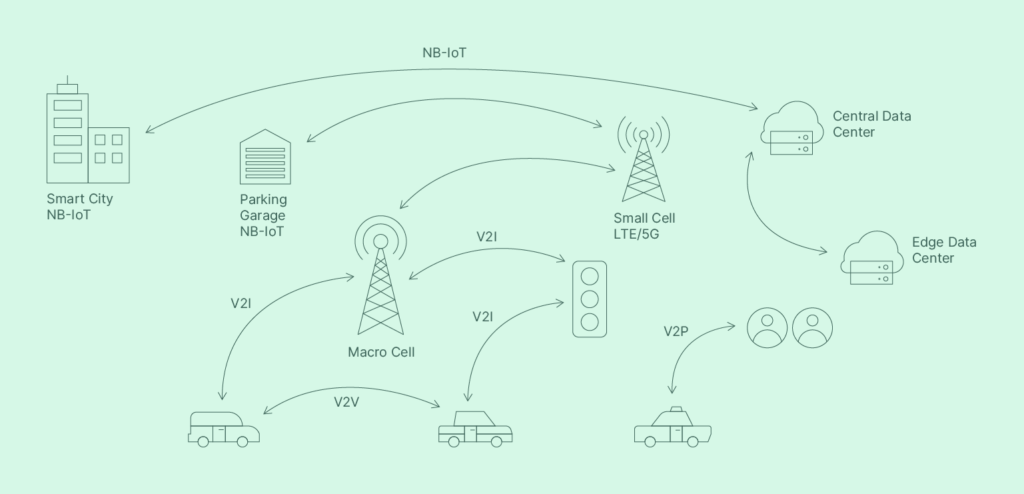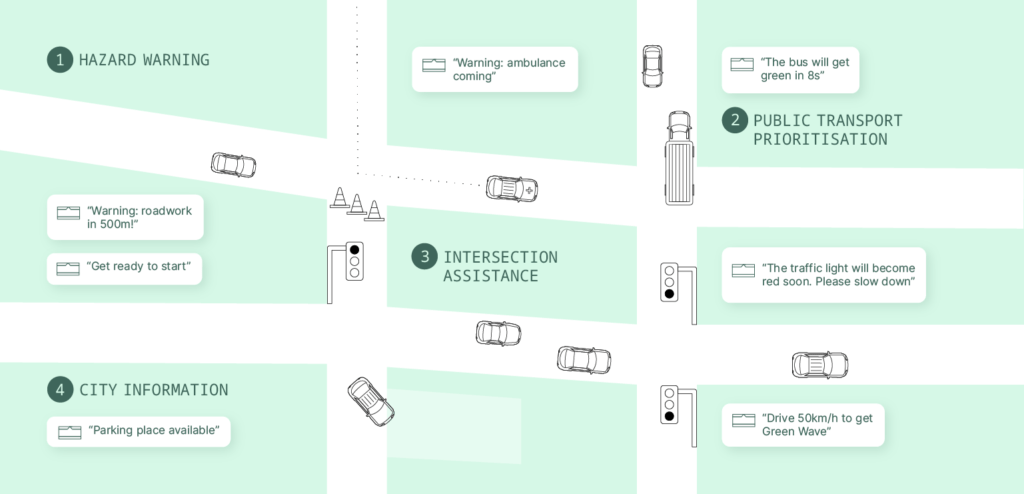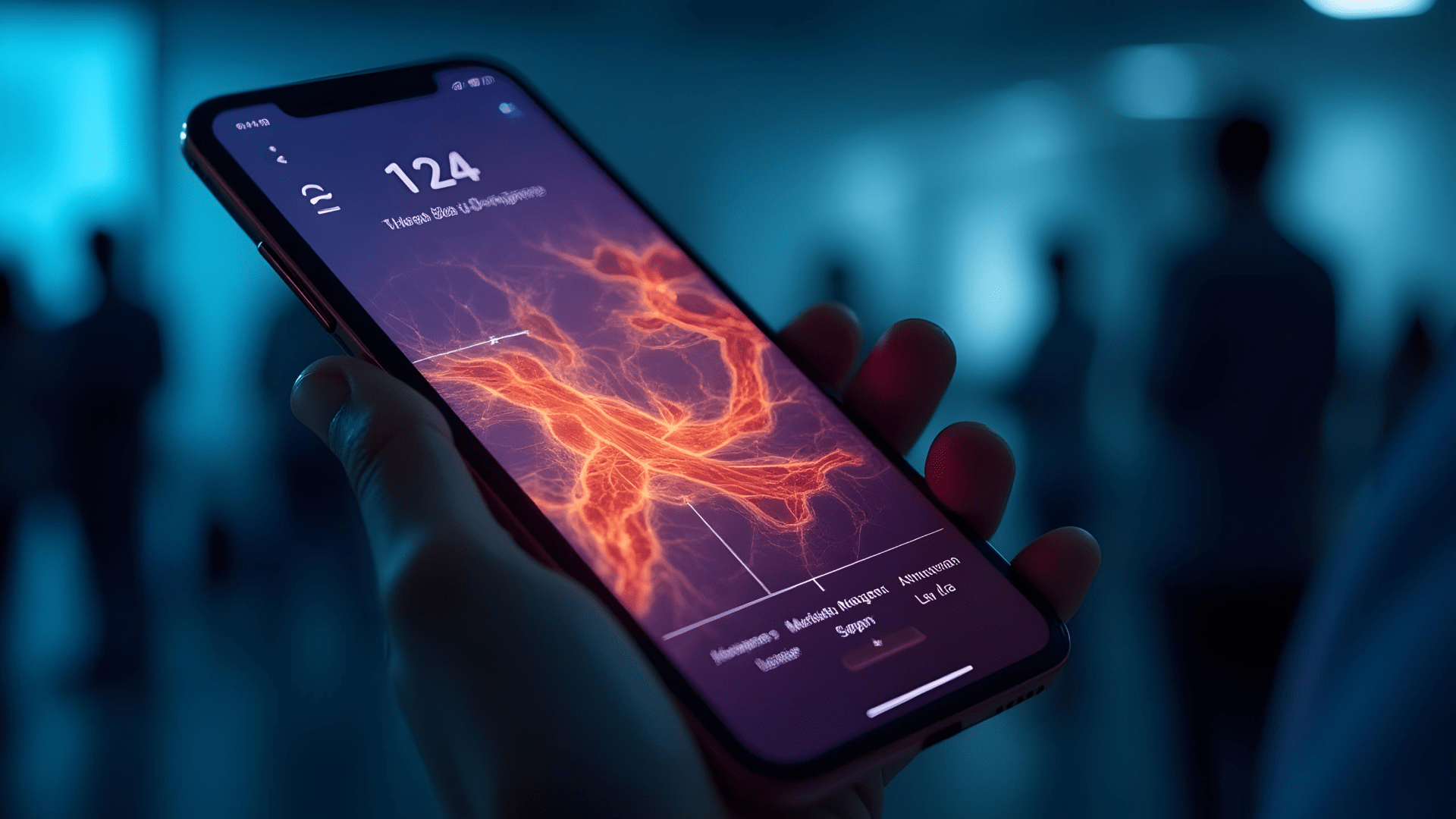Picture this scenario: You’re approaching an intersection, and your car’s sensors sense something you can’t yet see—an ambulance racing toward that same intersection from the left. Before panic sets in, a calm voice emerges from your car’s speaker, “There is an ambulance approaching from your left. Please yield.” V2X, in that moment, has just saved precious seconds, maybe even lives.
But V2X doesn’t stop there. It can make your daily commute smoother, too. Imagine your car receiving a signal from the traffic light ahead, telling it when the light will turn green. Your vehicle adjusts its speed, gliding smoothly through the intersection without a stop, reducing traffic congestion and fuel consumption.
These are the kinds of instances that ignite contemplation and intrigue in people’s minds.
What is V2x?
Imagine you’re driving down a busy avenue, surrounded by cars, cyclists, and pedestrians. Your car, a marvel of modern technology, is not just a vehicle anymore; it’s become a communicator, a guardian, a partner in your journey. V2X is the magic behind this transformation. At its core, V2X is like a language that vehicles speak to one another, to the traffic lights, to the road signs, and even to the people walking on the sidewalk. It’s a language of safety, efficiency, and convenience.
And it’s not just about your car talking to others; it’s about the whole transportation ecosystem becoming smarter. Traffic lights can adapt in real-time to ease congestion. Road signs can warn of dangers ahead. Even pedestrians can carry devices that communicate their presence to vehicles, enhancing safety at crosswalks.
In this article, we delve into the world of V2X, exploring its benefits, complexity, intriguing use cases, research results, and its potential impact on fleets and the world as we know it.
In V2X, what does “everything” actually include?
In the intricate web of Vehicle-to-Everything (V2X) communication, various components seamlessly collaborate to enable end-to-end connectivity. Let’s explore these components that underpin the foundation of V2X technology:
V2V: Vehicle to Vehicle Imagine a world where cars effortlessly share crucial data with one another—speed, location, and direction—all wirelessly and in real-time. This is the essence of Vehicle-to-Vehicle, or V2V, communication. It’s the technology that powers features like lane-change assistance and blind-spot detection in modern vehicles.
V2I: Vehicle to Infrastructure Now, envision cars having the ability to exchange information with the very infrastructure that surrounds them. This is Vehicle-to-Infrastructure, or V2I, in action. It’s when cars seamlessly communicate with connected road infrastructure, such as smart traffic lights and road signs, enhancing traffic management and safety.
V2P: Vehicle to Pedestrian In the bustling cityscape, cars equipped with V2P technology become attuned to their surroundings. Vehicle-to-Pedestrian, or V2P, communication allows cars to sense nearby pedestrians, encompassing not just those on foot but also bicyclists, strollers, and wheelchairs. Also, vehicle-to-pedestrian can enhance security by providing bidirectional communication between a bike rider and a car (speed and direction) and potentially warn of collision. This heightened awareness fosters safer urban mobility.
V2N: Vehicle to Network Now, let’s journey into the digital realm. Vehicle-to-Network, or V2N, communication is when cars engage in data exchange within network systems like LTE and 5G. This connectivity facilitates real-time updates and ensures vehicles stay in sync with the broader transportation ecosystem.
V2X: Vehicle-to-Everything In the grand orchestration of V2X technology, a car becomes a virtuoso, recognizing and communicating with all facets of transportation—V2V, V2I, V2P, and V2N. It’s a harmonious convergence of connectivity. Vehicles designed with V2X capabilities epitomize the pinnacle of connected vehicle technology, ushering us into an era where cars aren’t just modes of transport but intelligent entities seamlessly conversing with everything around them.
Platooning is another concept that offers immense value in revolutionizing how vehicles operate and interact with their surroundings. It involves a group of vehicles traveling closely together in a coordinated manner, almost like a convoy. The key feature of platooning is that these vehicles communicate with each other using Vehicle-to-Vehicle (V2V) or Vehicle-to-Everything (V2X) technology to maintain safe distances and synchronized movement. It presents significant advantages, from enhancing road safety by reducing the risk of human error and ensuring consistent speeds and safe following distances to a substantial improvement in fuel efficiency, as vehicles within a platoon can take advantage of reduced air resistance. This translates into cost savings for fleet operators and a significant reduction in carbon emissions, contributing to a greener environment.
Why is it important for innovations in vehicle-to-everything to be on everybody’s radar?

Safety, efficiency, convenience, and environmental sustainability are the key advantages of V2X.
In 2021, the National Highway Traffic Safety Administration (NHTSA) recorded an estimated 43,000 fatalities due to car accidents in the United States. However, V2X technology holds the potential to mitigate these statistics.
Here are some of the values this technology brings:
Enhanced Road Safety: V2X enables vehicles to communicate critical safety information, such as speed, position, and potential hazards, in real time. This data exchange helps prevent accidents by providing drivers with early warnings about dangerous situations, reducing the risk of collisions.
Reduced Traffic Congestion: V2X can optimize traffic flow by coordinating vehicle movements, reducing bottlenecks, and preventing traffic jams. This leads to smoother traffic patterns and shorter travel times.
Improved Traffic Management: Traffic lights and other infrastructure elements equipped with V2I technology can adapt in real-time to changing traffic conditions. They can optimize signal timings, prioritize emergency vehicles, and enhance overall traffic management.
Lower Fuel Consumption: By providing vehicles with information about traffic conditions and upcoming obstacles, V2X helps drivers make more fuel-efficient choices. Reduced idling time and smoother driving patterns contribute to lower fuel consumption and greenhouse gas emissions.
Increased Convenience: V2X technology can offer advanced navigation assistance, predictive maintenance alerts, and other features that enhance the driving experience. Drivers can receive real-time information about parking availability, road closures, and nearby services.
Support for Autonomous Vehicles: V2X plays a crucial role in the development and operation of autonomous vehicles. It provides these vehicles with real-time data on road conditions, traffic, and the surrounding environment, enabling safer and more efficient self-driving operations.
Emergency Vehicle Priority: V2X allows emergency vehicles to communicate with traffic signals and other vehicles, granting them priority access at intersections. This reduces response times during critical situations, potentially saving lives.
Pedestrian Safety: V2X technology can also enhance pedestrian safety by alerting drivers to the presence of pedestrians, bicyclists, and other vulnerable road users, reducing the risk of accidents.
Smart City Integration: V2X can be integrated into smart city infrastructure, contributing to better urban planning and management. It can support initiatives like traffic optimization, pollution control, and efficient transportation systems.
Environmental Benefits: By reducing traffic congestion and optimizing driving patterns, V2X can contribute to lower fuel consumption and greenhouse gas emissions, making transportation more environmentally friendly.
Cost Savings for Fleets: Fleet management can benefit significantly from V2X technology. Real-time data on vehicle performance and maintenance needs can help fleet operators reduce downtime and optimize their operations, leading to cost savings.
How confident are drivers about V2X?
Commsignia, a company headquartered in Santa Clara, California, specializing in the development and manufacturing of V2X equipment, conducted an online survey in October in 2022. The survey included 623 participants representing various genders, age groups, geographic locations, and income levels.
The survey found that respondents highly valued the following V2X capabilities, rating them as either “very” or “somewhat” useful:
- Expanding the range and capabilities of conventional blind spot sensors: 96.4%
- Offering real-time information about hazards like black ice, slippery roads, and objects on the road: 97%
- Decreasing trip durations, which leads to emission reduction: 94%
- Interacting with traffic lights to optimize traffic signal cycles and minimize waiting time at red lights: 96.3%
- Enhancing response times for emergency services during critical situations: 96.8%
Gartner forecasts that by 2025, over 50% of new vehicles will possess V2X capabilities, cementing its status as a mainstream automotive technology.
What are the complexities around V2X?
Vehicle-to-Everything (V2X) technology presents several complexities and challenges that must be addressed for its successful implementation and widespread adoption:
Technical Challenges: Developing and implementing the necessary communication protocols, hardware components, and software systems for V2X is a complex task. Ensuring that different vehicle makes and models can communicate effectively with each other and with infrastructure elements requires standardized protocols and robust cybersecurity measures.
Data Security and Privacy: The exchange of data between vehicles, infrastructure, and networks raises significant concerns about data security and privacy. Ensuring that sensitive information remains secure and protecting individuals’ privacy rights is a complex challenge that requires careful attention.
“The first thing that needs to be done is a serious uplift of the existing infrastructure. This is the most complex thing to do. While technology is already used in some cases, there are also cases, such as robo-taxis, where mobile network overloads can create traffic jams and “confusion” among the fleet of self-driving cars due to inadequate infrastructure.”
Standardization: Achieving industry-wide standardization for V2X technology is essential to ensure interoperability and seamless communication. The development and adoption of the USA and EU standards can be a complex and time-consuming process.
Infrastructure Deployment: To fully realize the benefits of V2X, extensive infrastructure upgrades may be required. This includes installing V2I communication equipment, smart traffic lights, and other elements. Coordinating these efforts on a large scale can be complex, both logistically and financially.
Regulatory and Legal Frameworks: Establishing the necessary regulatory and legal frameworks to govern V2X technology is a complex undertaking. These frameworks must address issues like liability, data ownership, and compliance with safety standards.
Consumer Adoption: Convincing consumers to embrace V2X technology can be complex, as it may require changes in behaviour and trust in the technology. Consumer education and awareness campaigns are essential to overcoming these challenges.
Interconnected Ecosystem: V2X doesn’t exist in isolation. It’s part of a broader connected ecosystem that includes autonomous vehicles, smart cities, and the Internet of Things (IoT). Coordinating these various components to work seamlessly together is a complex task.
Global Collaboration: Given that transportation is a global industry, achieving global collaboration and standards harmonization is complex but crucial for the successful deployment of V2X technology.
Safety and Reliability: Ensuring the safety and reliability of V2X systems is a complex challenge. Failures or vulnerabilities in these systems could have serious consequences, making robust testing and redundancy measures essential.

What does the future of V2X hold?
As per McKinsey’s projections, the global sales of connected vehicles are expected to witness significant growth, with approximately 95% of new vehicles sold worldwide projected to be connected by 2030, a notable increase from the current approximately 50%.
The future of Vehicle-to-Everything (V2X) technology holds significant promise and potential. Here are some key aspects of what the future might hold for V2X:
- Widespread Adoption: V2X technology is expected to become increasingly prevalent in vehicles and transportation infrastructure. As more vehicles and infrastructure elements become equipped with V2X capabilities, the benefits of enhanced safety, efficiency, and convenience will be accessible to a larger portion of the population.
- Integration with Autonomous Vehicles: V2X will play a critical role in the development and deployment of autonomous vehicles. These self-driving cars will rely on V2X communication to exchange data with other vehicles, pedestrians, and infrastructure, ensuring safe and efficient operation.
- Smart Cities: V2X technology is likely to be integrated into smart city initiatives. Traffic management, urban planning, and environmental sustainability efforts can benefit from the data and insights provided by V2X communication.
- Improved Traffic Management: V2X will continue to enhance traffic management by optimizing traffic flow, reducing congestion, and improving intersections’ efficiency. This will result in shorter commute times and reduced fuel consumption.
- Enhanced Safety: V2X will continue to improve road safety by providing real-time information about nearby vehicles, pedestrians, and potential hazards. Emergency vehicle prioritization and intersection management systems will further enhance safety.
- Environmental Impact: V2X can contribute to reducing greenhouse gas emissions by promoting more fuel-efficient driving patterns and reducing congestion. This aligns with global efforts to combat climate change.
- Fleet Management: Fleet operators will increasingly adopt V2X technology to optimize vehicle performance, reduce downtime, and enhance logistics and delivery operations.
- Standardization and Regulation: Ongoing efforts to standardize V2X protocols and regulations will continue, ensuring interoperability and security across different manufacturers and regions.
- Consumer Awareness: As V2X becomes more prevalent, consumer awareness and acceptance will grow. People will become more accustomed to the benefits of V2X technology and may come to expect it in their vehicles.
- Technological Advancements: Advances in communication technologies, such as 5G and beyond, will further enhance the capabilities of V2X systems, enabling faster and more reliable data exchange.
“It’s not only the human eye that must perceive things; automated vehicles and other devices must do so as well. This requires a uniform interpretation of signals, which presents a notable challenge. The accuracy of interpretation relies on the specific use case and the design that aligns with the operational domain. It’s not a matter of one being superior to the other but rather a question of how to foster inclusivity within the system.”
The Road Ahead
One of the major technical hurdles organizations come across when it comes to integrating V2X technology into vehicles revolve around creating widespread consensus between different industries (automotive, telco, consumer, and logistics).
“Effective collaboration relies on everyone within the ecosystem embracing an open mindset. In this context, the public sector is expected to fulfill several roles. One role involves shaping policies and regulations. Another vital role is to provide leadership and establish strategic objectives for the implementation of intelligent transport systems. Meanwhile, the private sector contributes by offering expertise and cutting-edge technologies, bridging the gap between business and technology.
The moment has arrived to embrace the ecosystem and foster collaboration that transcends industry boundaries to find new ways of innovating and partnering for success.
HTEC Group’s V2X solutions play a pivotal role in bridging the divide between experimental trials and the widespread implementation needed for cities, OEMs, telco providers, and value-added service providers. These solutions are the catalyst for driving transformative change within the automotive sector. To learn more about how we can help you on your transformation journey, reach out to Ivan Popovic, Engineering and Delivery, Automotive Lead at HTEC to discuss the opportunities that lie ahead or explore the services we offer here. In the meantime dive into the latest articles where our experts share their perspectives on latest trends and capabilities in automotive:
What to Expect from Shared Mobility





